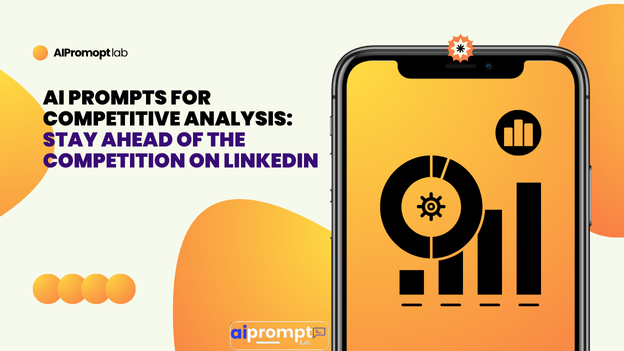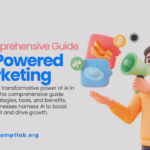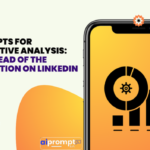
Competitive insights on LinkedIn with AI prompts. Learn strategies to stay ahead of the competition, enhance your professional profile, and boost your career success.
Introduction
It is one of the most important components in this sphere. Among the ways how to implement it right is through AI-based competitive analysis. We will be taking a look into the role that AI plays in competitor analysis on LinkedIn where you can unlock invaluable amounts of data about your competitors and the actions they take.
Understanding Competitive Analysis with AI
The first step of competitive analysis lies in recognizing what you are good at and which of your weaknesses you can improve. It is beneficial because you now get to have a thorough knowledge of their business models, the market, and the position they occupy. As AI gets more advanced, the process of developing new drugs has become more efficient and meaningful by making use of massive data. AI allows any software to quickly and efficiently analyze bountiful data and come up with tangible information that can aid your decision-making process.
10 Best AI Prompts for Competitive Analysis on LinkedIn

Profile Summary Insights: “Carefully assess the ‘summary profiles’ on LinkedIn, e.g., [competitor names], and highlight the visible relative skills, endorsements, and professional excellence that set their names in the industry apart.
Content Performance Metrics: “Audit the engagement metrics (likes, comments, shares) of the past couple of weeks’ posts from [competitor] names to identify the most engaging types of the brand’s content recognized by their audience. “
Connection Analysis: “Find out the main connections and social media reach of [competitor names] on LinkedIn to perceive the levels of their significance and networking strategy, which have a positive effect on their industry and its development. “
Skills and Expertise Comparison: “Compare the named competencies and proficiencies of our team with those of [competitors names] that are listed to highlight which areas require improvement at the same time as identifying the strengths that are specific only to us. “
Activity Trends: “Keep a close eye on the posting pattern and time of posting activity of [Competitor names] in the past half a year to have an insight into their strategies of engagement and most favorable times of the day. “
Endorsement Patterns: “Undertake the analysis of the communications received by [competing name] and discern the most repeatedly endorsed skills, as well as personalities providing them. ‘
Content Themes and Topics: “Examine the themes and topics covered in the LinkedIn articles and posts of [competitor names] to identify trending subjects and potential content gaps we can address.”
Audience Demographics: “Assess the demographics of the audience engaging with [competitor names] (e.g., job titles, industries, locations) to better understand their target market and tailor our outreach efforts.”
Engagement Tactics: ” Explore the engagement tactics that [competitors’ names] demonstrate through cool things such as hashtags, content with multimedia, as well as calls for action. These will help us develop our LinkedIn content strategy properly.
Influencer Interactions: “Pinpoint those dominating and powerful figures on LinkedIn whom [competitor names] are most often interacting within an attempt to discover areas where our team could align their efforts with these influencers or leaders. “
The Role of LinkedIn in Competitive Analysis
LinkedIn is exactly a great tool to use for networking among professionals. This tool is in the hands of companies and professionals who use it to display solid evidence of their accomplishments, inform the community about the latest news, and connect with colleagues from different industries. For a strategic rival analysis, LinkedIn is a potential trove of vital facts. A perusal of the LinkedIn profiles and activities of your competitors can help you unveil their strategies aimed at reaching the target, reviewing their performance, etc.
Benefits of Using AI for Competitive Analysis on LinkedIn
Using AI for competitive analysis on LinkedIn offers several benefits:
Speed and Efficiency: AI will be in a position to consider large data in a short period and, as a result, ensure that the data is up-to-date.
Accuracy: We can say that AI systems can give an exact analysis of data and let one see things that an ordinary person is not capable of detecting.
Actionable Insights: AI-obtained insights in turn are actionable, which is crucial to improving your strategies as the information gained proves to be helpful in decision-making.
Competitive Advantage: Knowing what competitors are up to allows you to recognize the gaps that you can capitalize on for the promotion of your brand.
Conclusion
Competitive Analysis is the main aspect that is kept in mind for leadership in the business environment can use AI to be able to know your competitors by LinkedIn profile and acts analysis. With knowledge of their approach and success, you can gain insight into their strategies. This exposure assists you in improving your forecasts, conducting more precise evaluations, and turning this information into a competitive advantage.






